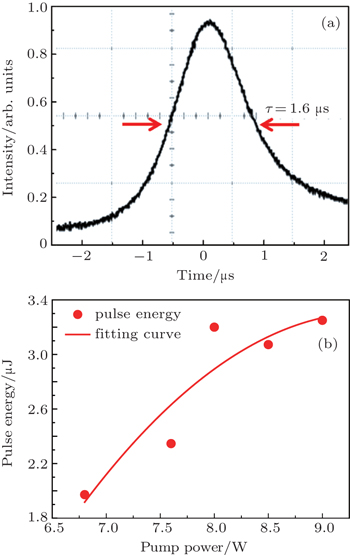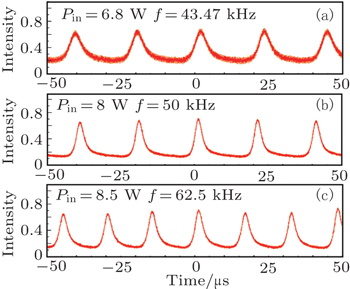† Corresponding author. E-mail:
‡ Corresponding author. E-mail:
Project supported by the National Scientific Research Project of China (Grant No. 61177047), Beijing Municipal Natural Science Foundation, China (Grant No. 1102005), and the Basic Research Foundation of Beijing University of Technology, China (Grant No. X3006111201501).
We demonstrate a passively Q-switched Yb:LSO laser based on tungsten disulphide (WS2) saturable absorber operating at 1034 nm and 1056 nm simultaneously. The saturable absorbers were fabricated by spin coating method. With low speed, the WS2 nanoplatelets embedded in polyvinyl alcohol could be coated on a BK7 glass substrate coated with high-refractive-index thin polymer. The shortest pulse width of 1.6 μs with a repetition rate of 76.9 kHz is obtained. As the pump power increases to 9 W, the maximum output power is measured to be 250 mW, corresponding to a single pulse energy of 3.25 μJ. To the best of our knowledge, this is the first time to obtain dual-wavelength Q-switched solid-state laser using few-layer WS2 nanoplatelets.
Synchronous dual-wavelength pulsed laser is well suitable to generate coherent terahertz (THz) radiation[1] and applied in pump–probe processes,[2] nonlinear frequency conversion,[3] etc. It has been reported that difference frequency generation of two Q-switched near infrared laser pulses could generate high peak power THz radiation.[4,5] Passively Q-switched solid-state laser favored the advantages of compactness, flexibility for generation of dual-wavelength laser. In previous works, many saturable absorbers (SAs) such as carbon materials[6–8] (carbon nanotubes, graphene, and graphene oxide), two-dimensional materials including topological insulators[9] and molybdenum disulphide (MoS2)[10] have been applied in solid-state lasers for Q-switching or mode locking. Recently, passively Q-switched dual-wavelength solid-state lasers have been realized based on graphene,[11] graphene oxide,[12] single-wall carbon nanotubes,[13] topological insulator,[14] and MoS2 saturable absorber,[15] respectively.
In two-dimensional materials, graphene research has reached a mature stage. However, as saturable absorber, the optics damage threshold of single-layer graphene is as low as 14 mJ/cm2.[16] Graphene-like material such as tungsten disulphide (WS2) has attracted much attention for its physical properties.[17] Monolayers of tungsten disulphide are proved to be stable under ambient conditions (room temperature in air)[18] and have emerged as candidate materials for future saturable absorbers. Recently, WS2 has been applied in fiber lasers. Mao et al. demonstrated an Er-doped mode-locked fiber laser with WS2 nanoplatelets (NPs).[19] Yan et al. realized 1 GHz harmonic mode-locking with pulse duration of 452 fs at 1.5 μm.[20] Wu et al. obtained a mode-locked Er-doped fiber laser at 1550 nm.[21] Zhao et al. obtained passively Q-switched laser operation with 60 ns pulse width and ultrafast mode locking with 8.6-ps pulse width.[22] These research results proved WS2 to be a potential high-power flexible saturable absorber for lasers.
In this paper, we demonstrate a Q-switched solid-state Yb:LSO laser based on WS2 nanoplatelet film. Q-switched pulses as short as 1.6 μs were obtained at the pump power of 9 W. The Q-switched laser delivered dual-wavelength output at wavelength of 1034.3 nm and 1056.8 nm simultaneously. At the maximum pump power of 9 W, the average output power is 250 mW, corresponding to pulse energy of 3.25 μJ. To the best of our knowledge, this is the first time to realize a passively Q-switched, dual-wavelength solid-state laser using WS2 as saturable absorber.
WS2 nanoplatelets could be fabricated by liquid-phase exfoliation due to the weak bonding between the WS2 layers, which made it possible to separate WS2 bulk into single molecular layers.[23] In our experiment, solution of WS2 nanoplatelets was fabricated by the liquid exfoliation.[24] The WS2 powder was dispersed with ethanol and water at the volume ratio of 50:50, and then the mixture was ultrasonically agitated for about 200 min. After ultrasonication, the solution was centrifuged at 3000 r/min for several times to move out the larger WS2 NPs. Hence, the WS2 solution was completed as shown in Fig.
The thickness of WS2 NPs ranges from 20 to 70 nm. The width and length of WS2 NPs fall within the range of about 200 nm. We test the Raman spectra of WS2 sample. The two characteristic peaks 
To prepare the WS2-SA, we used a BK7 glass substrate with high refractive index thin polymer of 96% at 1030 nm with a bandwidth of about 60 nm. After mixing WS2 solution with polyvinyl alcohol (PVA), WS2/PVA was spin coated on the substrate with low speed. Then the WS2 saturable absorber mirror (SAM) was finished.
The WS2 saturable absorber was inserted to a solid-state Yb:LSO laser and the schematic of the laser is shown in Fig.
 | Fig. 1. (a) WS2 dispersion after ultrasonication and centrifuging. (b) The AFM scan image of WS2 NPs and thickness of the WS2 film. |
The average output power of Yb:LSO laser with and without WS2-SA was plotted in Fig.
 | Fig. 4. (a) Average output power versus incident pump power for continuous wave and Q-switched operation. (b) Pulse width and repetition rate versus incident pump power for Q-switched operation. |
The laser performance was observed using a 1 GHz digital oscilloscope (Agilent, 54833A). Figure
 | Fig. 5. (a) Temporal profile of the shortest pulse under pump power of 9 W. (b) Pulse energy as a function of incident pump power. |
Finally, we observed the spectra for the CW and Q-switching operation. The results are shown in Figs.
Figure
A passively Q-switched dual-wavelength solid-state laser based on WS2 saturable absorber was demonstrated. Q-switching operated simultaneously at the center wavelengths of 1034.3 nm and 1056.8 nm. The pulse width and repetition rate were measured from 8 μs to 1.6 μs, and 34.5 kHz to 76.9 kHz, respectively. The maximum output power was 250 mW, corresponding to a single pulse energy of 3.25 μJ. To the best of our knowledge, it is the first time to obtain dual-wavelength Q-switching operation based on WS2-SA in solid-laser lasers.
| 1 | |
| 2 | |
| 3 | |
| 4 | |
| 5 | |
| 6 | |
| 7 | |
| 8 | |
| 9 | |
| 10 | |
| 11 | |
| 12 | |
| 13 | |
| 14 | |
| 15 | |
| 16 | |
| 17 | |
| 18 | |
| 19 | |
| 20 | |
| 21 | |
| 22 | |
| 23 | |
| 24 | |
| 25 | |
| 26 | |
| 27 | |
| 28 | |
| 29 | |
| 30 | |
| 31 | |
| 32 | |
| 33 |






